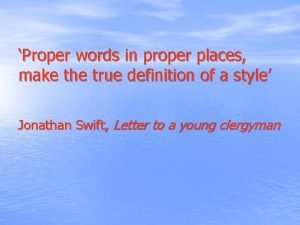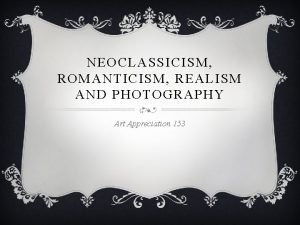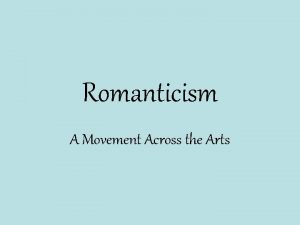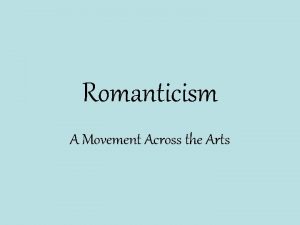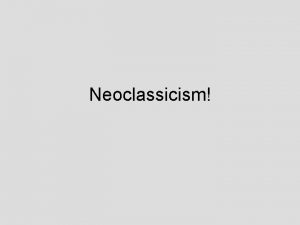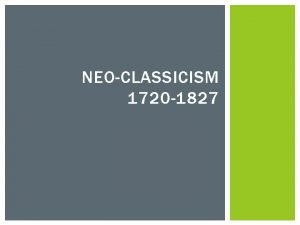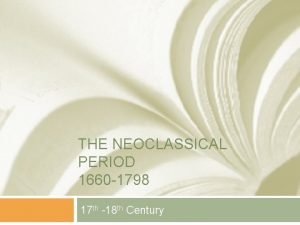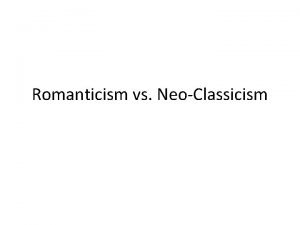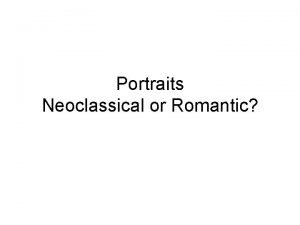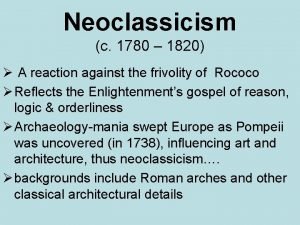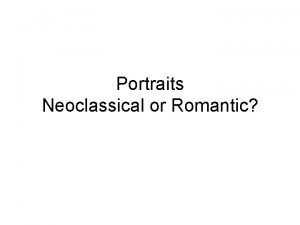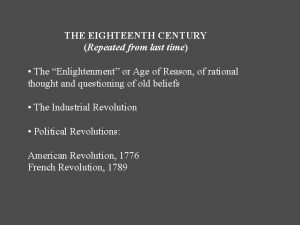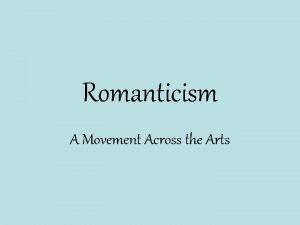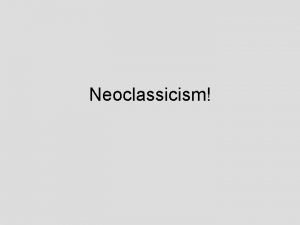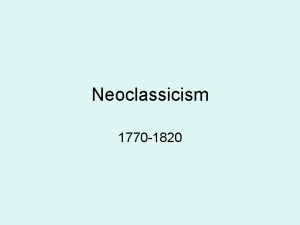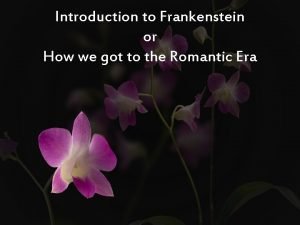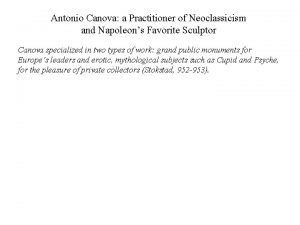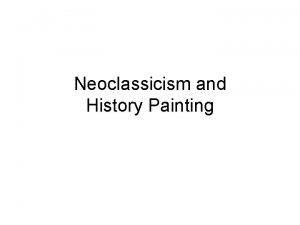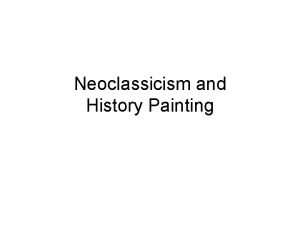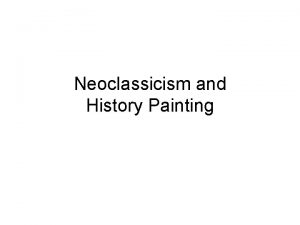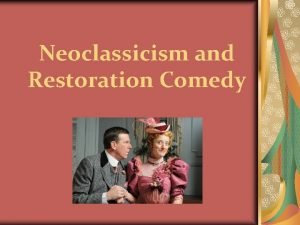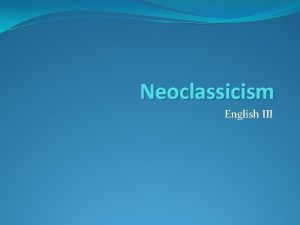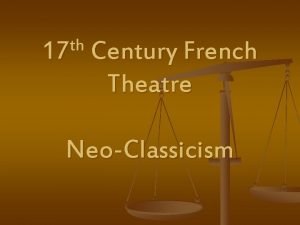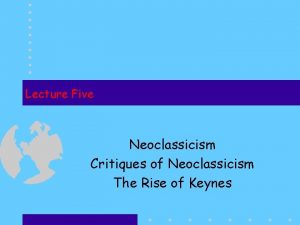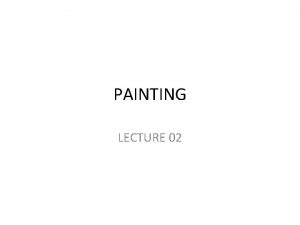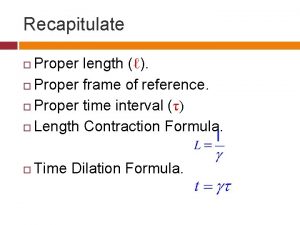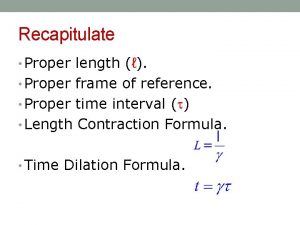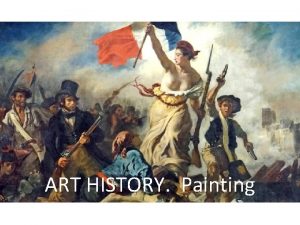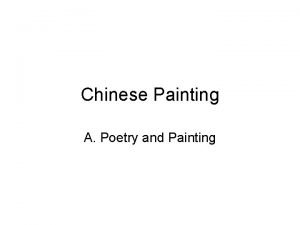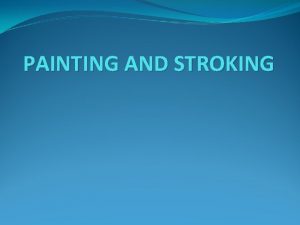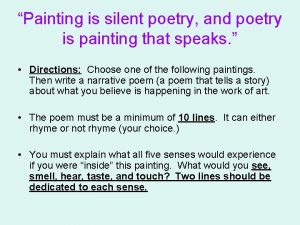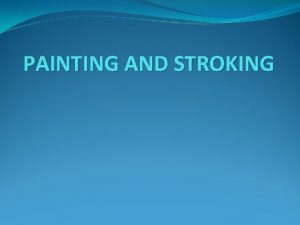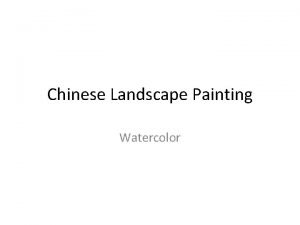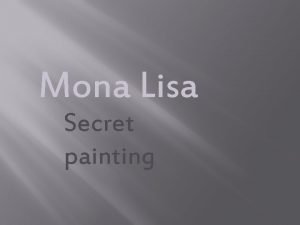Neoclassicism and History Painting What are the proper







































- Slides: 39

Neoclassicism and History Painting

What are the proper subjects of large scale paintings? 1. important scenes from history 2. scenes from The Bible 3. mythological scenes The very fact that these paintings are large signals that they are indeed important.

Gustave Courbet Burial at Ornans 1849 -50 oil on canvas, approx. 10’ x 20’ This work by Courbet was intended as a “history” painting, but the subject of this painting is the burial of a lower middle class person…. not a hero…the public was outraged by Courbet’s audacity….

Jacques-Louis David The Oath of the Horatii 1784 oil on canvas, 330 x 425 cm Musée du Louvre, Paris

David regarded this painting as his manifesto— a public declaration of his artisitc principles and intentions

This work is an excellent example of Neoclassicism— perhaps “the example. ” Why? This image represents a madeup event. Louis XVI (and France’s minister of the arts Count d’Angiviller) believed that art should improve public morals. Jacques-Louis David The Oath of the Horatii 1784 What is this image meant to teach he viewer?

Remember: Neoclassicism was a movement begun primarily by one very influential man: Johann Winckelmann. He worked for Cardinal Albani in Rome as a secretary and librarian. The Cardinal had a massive collection of antiquities—Greek and Roman art. Winckelmann published a pamphlet, Thoughts on the Imitation of Greek Work in Painting and Sculpture that was enormously influential. In this pamphlet Winckelmann 1. attacked Rococo as “decadent” (Count d’Angiviller actually banned indecent nudity from the Salon of 1775) and 2. argued that only through the imitation of classical models could art become great once again. François Boucher The Bath of Venus 1751

According to the story, during the early republican period of Rome (before Cesar), Rome and Alba had been at war for some time, when the two city-states decided to resolve the conflict by having the three best soldiers from each side fight to the death. Jacques-Louis David The Oath of the Horatii The three Roman sons of Horace —the Horatii—would fight against the Curatii (Alba). Significantly, the women in the image have conflicting ties: one (Sabina in the middle) is a sister of one of the Curatii but is married to a Horatii; the other, Camilla is engaged to a Curatii. How would you as the viewer, describe the posture of the men compared to the posture of the women? the men: stoic, willing to sacrifice themselves for the State the women: their primary commitment is to their families and familial bonds

Angelica Kauffmann Cornelia Pointing to Her Children as Her Treasures 1785 …under Cornelia’s loving care, the sons, Tiberius and Gaius Gracchus, grew up to be political reformers…. the message: be a good mother!

Benjamin West The Death of General Wolfe 1770 oil on canvas

West made this image about a decisive battle fought at Quebec City in 1759 almost ten years later. What is West trying to argue about the British army to England in The Death of General Wolfe? What has West deliberately altered to dramatize the moment and create a sense of heightened response in the viewer?

Answer: Wolfe has sacrificed himself for the good of the state—for Britain in it’s battle for territory against the French Answer: Wolfe dies in the middle of the entire British army (not under a tree with a few attendants); Wolfe dies under a dramatic sky that (in a moment of pathetic fallacy) seems dark with grief (and the smoke from the battle); West throws in a Native-American to add an element of the “exotic” even thought the Native-Americans fought on the French side…

Benjamin West The Death of General Wolfe 1770 oil on canvas

John Trumbull The Death of General Warren at the Battle of Bunker’s Hill, June 17, 1775 1786 oil on canvas

Trumbull made this image about a decisive battle fought at Breed’s Hill in 1786 almost ten years later. The Americans lost the battle after three attacks at Breed’s Hill; the Americans ran out of gunpowder. The British gained Breed’s Hill but lost 1, 000 men—three times as many as the Americans lost. Notice that in the image British Major John Small keeps Warren from being bayoneted. British Major John Pitcairn falls dying. British Generals Howe and Clinton charge up the hill. American General Putnam leads a retreat. Lieutenant Grosvenor (from Connecticut) is wounded in chest and hand—reacts to Warren’s death.

British Generals Howe and Clinton charge up the hill. American General Putnam leads a retreat. British Major John Pitcairn falls dying. British Major John Small Lieutenant Grosvenor (from Connecticut) reacts to Warren’s death.

1. What is Trumbull trying to argue to a new country—a fledgling democracy-- in The Death of General Warren? 2. What is the purpose of this work? 3. How has Trumbull deliberately structured the scene to dramatize the moment and create a sense of heightened response in the viewer? 4. How many important personages are crammed in this scene? 5. Is this work Neoclassical in nature?

John Singleton Copley Samuel Adams c. 1770 -1772 Oil on canvas March 5, 1770—the Boston Massacre (really a street fight between colonial ruffians and British soldiers); the day after, Adams demanded that Governor Hutchinson—the representative of the crown —remove all British troops from the city of Boston. This image was painted shortly after the event. What is Copley trying to argue to the colonialists?

John Singleton Copley Samuel Adams • with his left hand, Adams points to the charter granted tp Massachusetts by King Williams and Queen Mary • in the other hand he tightly holds the petition prepared by the aggrieved citizens of Boston • the defiant stance and emphatic gesture are meant to convey the moral force of his reasonable demands • note the direct gaze This man is not a servant of the crown: he is a citizen.

Jacques-Louis David The Death of Marat 1793 oil on canvas, approx 5’ x 4’ A supreme example of both Neoclassicism as well as history painting…Why? Jean-Paul Marat was a radical pamphleteer (a writer of incendiary pamphlets) for the Jacobians (the egalitarian democrats who presided over the reign of terror— remember Robespierre? ). He was murdered by Charlotte Corday. With a knife. In his bath.

Jacques-Louis David The Death of Marat 1793 oil on canvas, approx 5’ x 4’ This work constructs Marat as an icon figure of the French Revolution: he is at once like a classical god and a religious martyr.

Jacques-Louis David Head of the Dead Marat 1793 Pen, black and brown ink, 270 x 210 mm Musée National du Château, Versailles

Jacques-Louis David The Death of Socrates 1787 A supreme example of both Neoclassicism as well as history painting…Why?

Portraits Neoclassical or Romantic?

Romanticism is a complex artistic, literary, and intellectual movement that originated in the second half of the 18 th century in Western Europe. In part, it was a revolt against aristocratic social and political norms of the Age of Enlightenment and a reaction against the scientific rationalization of nature, and was embodied most strongly in the visual arts, music, and literature, but can be detected even in changed attitudes towards children and education. The movement validated strong emotion as an authentic source of aesthetic experience, placing new emphasis on such emotions as trepidation, terror, horror and awe—especially that which is experienced in confronting the sublimity of untamed nature and its picturesque qualities, both new aesthetic categories.

Romanticism In European painting, led by a new generation of the French school, the Romantic sensibility contrasted with the Neoclassicism being taught in the academies. In a revived clash between color and design, the expressiveness of color, as in works of Turner, Gericault, and Delacroix, was emphasized in the new prominence of the brushstroke and impasto and in the artist's free handling of paint, which tended to be repressed in neoclassicism under a self-effacing finish. In literature—among others—Edgar Allan Poe, Nathaniel Hawthorne, Johann Wolfgang von Goethe, William Wordsworth, Samuel Taylor Coleridge, William Blake, Lord Byron, Percy Bysshe Shelley, Mary Shelley, and John Keats.

Jacques-Louis David Portrait of Antoine-Laurent and Marie-Anne Lavoisier 1788 Oil on canvas, 256 x 195 cm Metropolitan Museum of Art, New York This work portrays one of the ideals of the Enlightenment: have faith in reason and empirical knowledge; after her marriage to Antoine-Laurent, Marie-Anne soon became interested in his scientific research and began to actively participate in his laboratory work; the majority of the research effort put forth in the laboratory was done by both together—and despite all this, Marie-Anne still was able to remain decorative….

Jacques-Louis David Portrait of the Marquise d'Orvilliers 1790 oil on canvas, 131 x 98 cm Musée du Louvre, Paris

Jacques-Louis David Portrait of Madame Adélaide Pastoret 1791 -92 oil on canvas, 130 x 97 cm Art Institute, Chicago

Jacques-Louis David Madame Raymond de Verninac 1798 -99 oil on canvas, 145 x 112 cm

Jacques-Louis David Madame Récamier Oil on canvas 173 x 244 cm 1800 Musée du Louvre, Paris

Élisabeth Vigee-Lebrun Portrait of Anna Pitt as Hebe 1792 Oil on canvas, 140 x 100 cm The Hermitage, St. Petersburg Hebe is the goddess of youth; she is the daughter of Zeus and Hera. Is this a Neoclassical painting?

Joshua Reynolds Mrs. Musters as Hebe 1785 Oil on canvas, 239 x 144, 8 cm Hebe is the goddess of youth; she is the daughter of Zeus and Hera. Is this a Neoclassical painting?

Joshua Reynolds Lady Elizabeth Delmé and her Children 1777 -80 Oil on canvas, 239 x 147 cm Is this a Neoclassical painting? Is it a Romantic painting? Is this a “good mother” painting?

Élisabeth Vigee-Lebrun Self-Portrait with Her Daughter, Julie 1786 Oil on wood, 105 x 84 cm Is this a Neoclassical painting? Is it a Romantic painting? Is this a “good mother” painting?

Élisabeth Vigee-Lebrun Marie Antoinette with Her Children 1787 oil on canvas Is it a Romantic painting? Is this a “good mother” painting? Is this a “history” painting?

Thomas Gainsborough Mr. and Mrs. Andrews 1748 -49

Thomas Gainsborough Mr. and Mrs. William Hallett (The Morning Walk) 1785 Does this work emphasize one of the new values of the Enlightenment: the emphasis on nature and the natural as a source of goodness and beauty?

To come…genre painting…and wacky Fuseli…not the pasta…. Important Artists still to come…. William Hogarth Joseph Wright John Henry Fuseli Jean Baptiste Greuze
 Antigentest åre
Antigentest åre Proper places
Proper places History of oil painting
History of oil painting Romanticism and neoclassicism
Romanticism and neoclassicism Neoclassicism vs realism
Neoclassicism vs realism Romanticism vs neoclassicism
Romanticism vs neoclassicism Neoclassicism vs romanticism art
Neoclassicism vs romanticism art Characteristics of neoclassical
Characteristics of neoclassical Neo classical characteristics
Neo classical characteristics Neoclassical age
Neoclassical age Charles barry neoclassical or romantic
Charles barry neoclassical or romantic Neoclassical portraits
Neoclassical portraits Neoclassicism was a reaction against
Neoclassicism was a reaction against Lombroso biological positivism
Lombroso biological positivism Neoclassicism portraits
Neoclassicism portraits Third of may 1808
Third of may 1808 Visual artist definition
Visual artist definition Neoclassical era art
Neoclassical era art Neoclassicism
Neoclassicism Apotheosis of homer neoclassical
Apotheosis of homer neoclassical Neoclassical vs romanticism
Neoclassical vs romanticism Neoclassicism napoleon
Neoclassicism napoleon Hát kết hợp bộ gõ cơ thể
Hát kết hợp bộ gõ cơ thể Lp html
Lp html Bổ thể
Bổ thể Tỉ lệ cơ thể trẻ em
Tỉ lệ cơ thể trẻ em Voi kéo gỗ như thế nào
Voi kéo gỗ như thế nào Chụp phim tư thế worms-breton
Chụp phim tư thế worms-breton Hát lên người ơi alleluia
Hát lên người ơi alleluia Môn thể thao bắt đầu bằng chữ đua
Môn thể thao bắt đầu bằng chữ đua Thế nào là hệ số cao nhất
Thế nào là hệ số cao nhất Các châu lục và đại dương trên thế giới
Các châu lục và đại dương trên thế giới Cong thức tính động năng
Cong thức tính động năng Trời xanh đây là của chúng ta thể thơ
Trời xanh đây là của chúng ta thể thơ Mật thư tọa độ 5x5
Mật thư tọa độ 5x5 101012 bằng
101012 bằng độ dài liên kết
độ dài liên kết Các châu lục và đại dương trên thế giới
Các châu lục và đại dương trên thế giới Thơ thất ngôn tứ tuyệt đường luật
Thơ thất ngôn tứ tuyệt đường luật Quá trình desamine hóa có thể tạo ra
Quá trình desamine hóa có thể tạo ra

